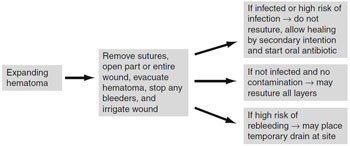Surgical Complications | | Figure 6.5 Algorithm for expanding hematoma |
- Risk of bleeding greatest in first 48 h (especially in immediate postoperative period)
- Provides medium for bacteria, prevents wound healing, ↑ wound tension (± dehiscence)
- Two types of hematoma: stable and expanding
- Stable hematoma
- Non-expanding ecchymotic firm to fluctuant mass with sensation of pressure
- Small, stable, non-infected, and not compromising tissue viability → no surgical intervention necessary (observation w/ warm compresses to hasten resorption)
- Expanding hematoma (Figure 6.5)
- Enlarging ecchymotic fluctuant to firm mass with new onset pain (often throbbing)
- Medical emergency if expanding hematoma in periorbital or cervical locations
- If very early hematoma (warm, swollen, fluctuant) → intervention recommended to prevent further progression (same intervention as for expanding hematoma)
- If late hematoma (liquefactive stage, 7–10 days after formation) → may aspirate w/ needle
|
